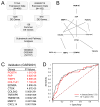Suboptimal cytoreduction in ovarian carcinoma is associated with molecular pathways characteristic of increased stromal activation
- PMID: 26348314
- PMCID: PMC4679504
- DOI: 10.1016/j.ygyno.2015.08.026
Suboptimal cytoreduction in ovarian carcinoma is associated with molecular pathways characteristic of increased stromal activation
Abstract
Objective: Suboptimal cytoreductive surgery in advanced epithelial ovarian cancer (EOC) is associated with poor survival but it is unknown if poor outcome is due to the intrinsic biology of unresectable tumors or insufficient surgical effort resulting in residual tumor-sustaining clones. Our objective was to identify the potential molecular pathway(s) and cell type(s) that may be responsible for suboptimal surgical resection.
Methods: By comparing gene expression in optimally and suboptimally cytoreduced patients, we identified a gene network associated with suboptimal cytoreduction and explored the biological processes and cell types associated with this gene network.
Results: We show that primary tumors from suboptimally cytoreduced patients express molecular signatures that are typically present in a distinct molecular subtype of EOC characterized by increased stromal activation and lymphovascular invasion. Similar molecular pathways are present in EOC metastases, suggesting that primary tumors in suboptimally cytoreduced patients are biologically similar to metastatic tumors. We demonstrate that the suboptimal cytoreduction network genes are enriched in reactive tumor stroma cells rather than malignant tumor cells.
Conclusion: Our data suggest that the success of cytoreductive surgery is dictated by tumor biology, such as extensive stromal reaction and increased invasiveness, which may hinder surgical resection and ultimately lead to poor survival.
Keywords: Cancer-associated stroma; Cytoreductive surgery; Debulking; Desmoplasia; Epithelial–mesenchymal transition; Invasion; Metastasis; Ovarian cancer.
Copyright © 2015. Published by Elsevier Inc.
Conflict of interest statement
The authors declare no conflict of interest.
Figures




Comment in
-
Suboptimal cytoreduction: the confounding effects of tumor biology.Gynecol Oncol. 2015 Dec;139(3):389-90. doi: 10.1016/j.ygyno.2015.10.026. Gynecol Oncol. 2015. PMID: 26651457 No abstract available.
Similar articles
-
Gene signature characteristic of elevated stromal infiltration and activation is associated with increased risk of hematogenous and lymphatic metastasis in serous ovarian cancer.BMC Cancer. 2019 Dec 30;19(1):1266. doi: 10.1186/s12885-019-6470-y. BMC Cancer. 2019. PMID: 31888563 Free PMC article.
-
Preoperative predictors of suboptimal primary surgical cytoreduction in women with clinical evidence of advanced primary epithelial ovarian cancer.Int J Gynecol Cancer. 2004 Jan-Feb;14(1):42-50. doi: 10.1111/j.1048-891x.2004.14065.x. Int J Gynecol Cancer. 2004. PMID: 14764028
-
[Clinical observation of partial pancreatectomy as part of primary cytoreductive surgery in advanced epithelial ovarian cancer].Zhonghua Fu Chan Ke Za Zhi. 2016 May 25;51(5):361-5. doi: 10.3760/cma.j.issn.0529-567X.2016.05.008. Zhonghua Fu Chan Ke Za Zhi. 2016. PMID: 27256444 Chinese.
-
Radical surgery in ovarian cancer.Curr Oncol Rep. 2015 Apr;17(4):16. doi: 10.1007/s11912-015-0439-z. Curr Oncol Rep. 2015. PMID: 25708800 Review.
-
Debulking Surgery for Clear Cell Carcinoma of the Ovary - A Case Report and Literature Review.Anticancer Res. 2017 Oct;37(10):5707-5711. doi: 10.21873/anticanres.12008. Anticancer Res. 2017. PMID: 28982890 Review.
Cited by
-
Mapping three-dimensional intratumor proteomic heterogeneity in uterine serous carcinoma by multiregion microsampling.Clin Proteomics. 2024 Jan 22;21(1):4. doi: 10.1186/s12014-024-09451-2. Clin Proteomics. 2024. PMID: 38254014 Free PMC article.
-
Dilution of Molecular-Pathologic Gene Signatures by Medically Associated Factors Might Prevent Prediction of Resection Status After Debulking Surgery in Patients With Advanced Ovarian Cancer.Clin Cancer Res. 2020 Jan 1;26(1):213-219. doi: 10.1158/1078-0432.CCR-19-1741. Epub 2019 Sep 16. Clin Cancer Res. 2020. PMID: 31527166 Free PMC article.
-
Understanding the matrix: collagen modifications in tumors and their implications for immunotherapy.J Transl Med. 2024 Apr 24;22(1):382. doi: 10.1186/s12967-024-05199-3. J Transl Med. 2024. PMID: 38659022 Free PMC article. Review.
-
Blood Plasma Small Non-Coding RNAs as Diagnostic Molecules for the Progesterone-Receptor-Negative Phenotype of Serous Ovarian Tumors.Int J Mol Sci. 2023 Jul 30;24(15):12214. doi: 10.3390/ijms241512214. Int J Mol Sci. 2023. PMID: 37569592 Free PMC article.
-
Post-operative residual disease and number of cycles of neoadjuvant chemotherapy in advanced epithelial ovarian carcinoma.Int J Gynecol Cancer. 2023 Aug 7;33(8):1270-1278. doi: 10.1136/ijgc-2022-004249. Int J Gynecol Cancer. 2023. PMID: 37429642 Free PMC article.
References
-
- Bristow RE, Tomacruz RS, Armstrong DK, Trimble EL, Montz FJ. Survival effect of maximal cytoreductive surgery for advanced ovarian carcinoma during the platinum era: a meta-analysis. J Clin Oncol. 2002;20:1248–59. - PubMed
-
- Chi DS, Zivanovic O, Palayekar MJ, Eisenhauer EL, Abu-Rustum NR, Sonoda Y, et al. A contemporary analysis of the ability of preoperative serum CA-125 to predict primary cytoreductive outcome in patients with advanced ovarian, tubal and peritoneal carcinoma. Gynecol Oncol. 2009;112:6–10. - PubMed
Publication types
MeSH terms
Grants and funding
LinkOut - more resources
Full Text Sources
Other Literature Sources
Medical

